Salisbury's World War Two hospital still in use 80 years on
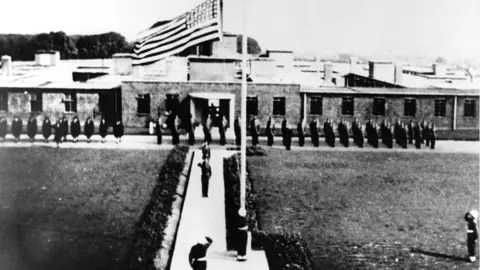 ArtCare, Salisbury District Hospital
ArtCare, Salisbury District HospitalIn 1943, as the United States dealt with the escalating conflict of World War Two, in an area of Salisbury called Odstock, the American military opened a hospital.
Made from red brick and corrugated iron, the building was reportedly designed to be wide enough to drive a US army jeep through its corridors, and was expected to be a temporary site for thousands of soldiers stationed in Europe.
But 80 years on, the hospital's patients are very different, but some of their treatment still happens inside the historic buildings.
The flat rooves, uniform red brick and dead straight corridors are a constant nod to Salisbury District Hospital's military origins.
The offices of management, such as the CEO, sit in the same place where the American military top brass once worked.
There is even still a flagpole on the green and archive pictures show a huge star-spangled banner once flew from it.
The flag itself was left behind and is now carefully wrapped up as part of the hospital's collection.
The perfectly straight and long corridors were rumoured to be able to fit an American army jeep down them - something tried and tested more recently with re-enactors.

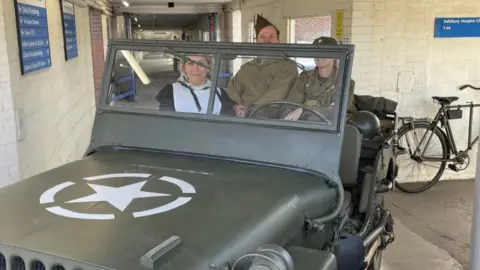 Salisbury District Hospital
Salisbury District HospitalThe Americans arrived in December 1942 and it officially opened in March 1943 - a quick turnaround.
However, locals had already been laying down the foundations.
A bricklayer from the time - Ted Trowbridge from Bowerchalke - said he was paid around one shilling and nine pence an hour.
War hospital life
Nissen huts, the well-known rounded structures of World War Two Britain, were in abundance.
They may have been hardy, but they did not have many of the comforts of home.
Lesley Self - who manages the hospital's huge archive - explained "there was no sanitation inside the huts. There were beds and there was an ablution block outside and they were heating by a pot-bellied stove.
"A bit like a log burner in the middle of the ward. Really this is one up from being inside a tent."
There were a few used to house prisoners of war too.
The huts were all replaced after the war - eventually. Some were in use as late as the 1980s, including as maternity wards.
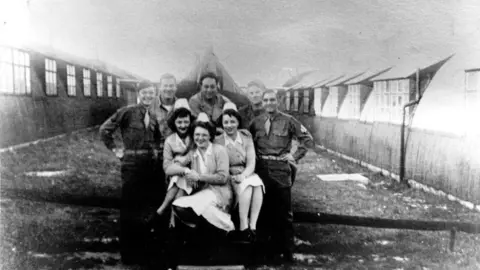 ArtCare, Salisbury District Hospital
ArtCare, Salisbury District Hospital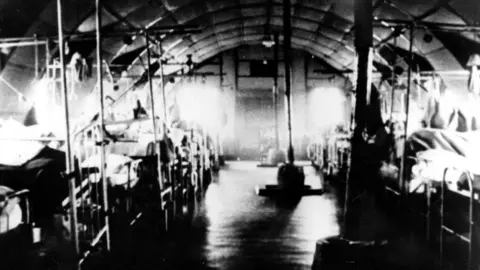 ArtCare, Salisbury District Hospital
ArtCare, Salisbury District HospitalWhile the hospital has put in modern buildings on top of many of the older ones, like the nissen huts, a huge number are still there - including the old pharmacy, what is now the maternity ward, offices and the old mess hall is one of the cafes.
Ms Self said: "I think it's always fascinating to see that some of the buildings have continued to be the same use.
"For example, the officers' dining and recreation room, that's actually where Hedgerows Coffee Shop is now.
"The photograph says 'we queue up at the mess hall hall for our typical gourmet dinner' - and gourmet is in exclamation marks - so they didn't think much of the food", she added.
Local residents though appreciated any cuisine that arrived from across the Atlantic, with Ms Self telling the story of a woman who was 17 at the time remembering "quite vividly the taste of things like frankfurters, meatballs and dips. She said they were quite foreign to everybody."
 ArtCare, Salisbury District Hospital
ArtCare, Salisbury District Hospital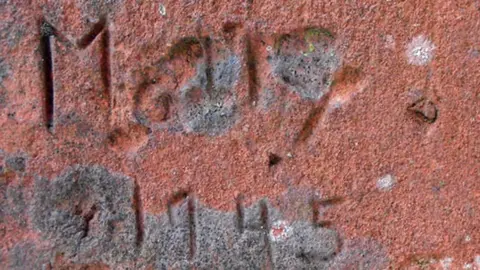 ArtCare/Salisbury District Hospital
ArtCare/Salisbury District HospitalThere are memories literally etched into the brickwork too, with graffiti left by the soldiers who were there. One reads "Salix, Iowa", a place in the US, another "Mary, 1945." Ms Self suspects "Gladys" was also probably a girlfriend from the time.
The carvings are beside what is now known as Entrance B, which is where the original entrance and guard post would have been.

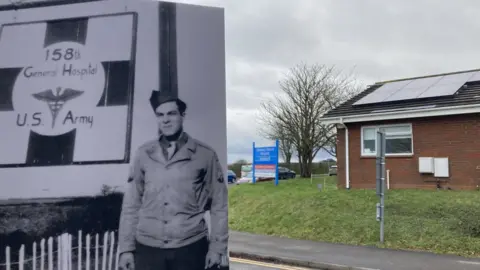
10,000 casualties
Ms Self explained that the hospital was not just for the extensive training area on Salisbury Plain, but actually took in casualties who arrived from abroad.
More than 10,000 casualties came through the hospital during World War Two, with many of these admitted after D-Day in June 1944.
"It had specialisms for things like neurosurgery, burns and plastic surgery, so a lot of casualties with things like head trauma came to be treated by experts.
"Surgeons from America were here doing that work."
 ArtCare, Salisbury District Hospital
ArtCare, Salisbury District Hospital"Reset the brain"
An American researcher found and sent to the hospital a copy of a document in archives in the US which gives more insight into treatment at Salisbury, including for mental health: "A lot of the patients were suffering from things like shellshock, or what we'd call PTSD nowadays" Ms Self said.
"There was a lot of mental rehabilitation, like education and reassurance, individual psychotherapy.
"In extreme cases, they would use a modified insulin therapy, which was quite a brutal treatment.
"It was given to induce a diabetic coma, which reset the brain. It's probably of its era," she added.
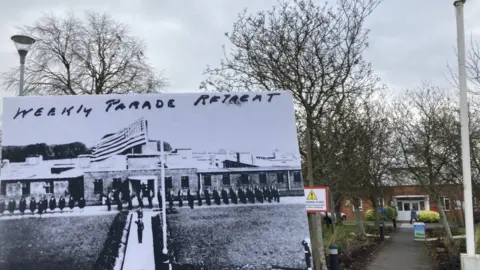 Artcare, Salisbury District Hospital
Artcare, Salisbury District HospitalMs Self also told the story of the first patient, who was rumoured to be a soldier new to the place: "A crowd of them went to the Yew Tree pub, which is at the bottom of the hill from this site.
"Eddie and his buddy went in a jeep. And a friend of theirs went down on a push bike.
"Come turning out time he decided that coming up the hill on his push bike was too much like hard work, so they towed him on the jeep.
"It was always going to end in tears. If you know the road, it's quite steep, it's got a sharp S bend.
"He falls off and apparently broke his arm and collarbone and supposedly is the first casualty for the American hospital."
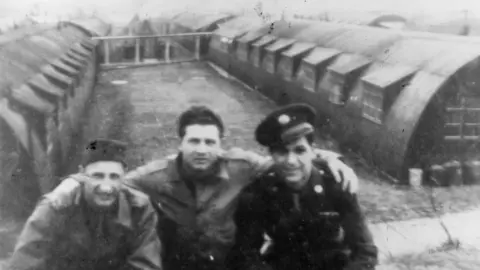 ArtCare, Salisbury District Hospital
ArtCare, Salisbury District HospitalAfter the war, the Americans left in 1946 and the hospital was handed to the local authorities.
After that, people in the Salisbury area were treated at the Salisbury Infirmary in the city centre and the war site.
30 years ago, the infirmary site moved fully to the World War Two area at Odstock, with the final phase of the shift taking just 10 days.

Follow BBC West on Facebook, X and Instagram. Send your story ideas to: [email protected]
